The Impact of Inadequate Funding on Long Term Care in Ontario
VerifiedAdded on 2022/08/23
|10
|2173
|19
Report
AI Summary
This report analyzes the critical issue of inadequate funding in Ontario's long-term care (LTC) sector, highlighting its detrimental effects on patient care and the overall quality of services. The report begins by outlining the current state of LTC in Ontario, including the aging population's increasing healthcare needs and the financial constraints faced by LTC homes. It then delves into the problems caused by insufficient funding, such as staffing shortages, increased risks, and a decline in the quality of care. The report further explores the strategies for resolving these issues, including hiring more nurses, implementing healthcare service strategies, and advocating for policy changes. By examining these strategies, the report aims to provide a comprehensive understanding of the challenges and potential solutions to improve the long-term care system in Ontario.
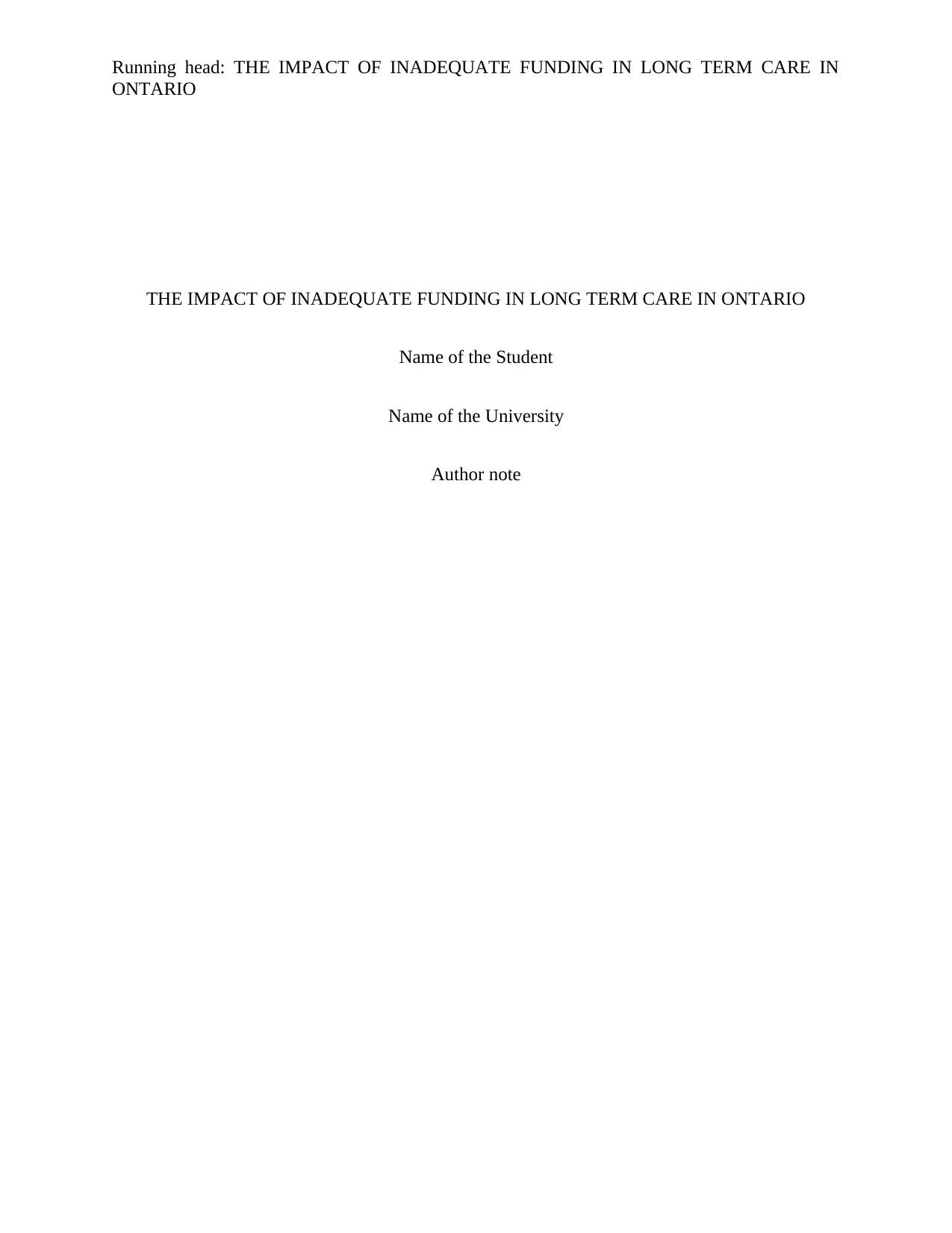
Running head: THE IMPACT OF INADEQUATE FUNDING IN LONG TERM CARE IN
ONTARIO
THE IMPACT OF INADEQUATE FUNDING IN LONG TERM CARE IN ONTARIO
Name of the Student
Name of the University
Author note
ONTARIO
THE IMPACT OF INADEQUATE FUNDING IN LONG TERM CARE IN ONTARIO
Name of the Student
Name of the University
Author note
Paraphrase This Document
Need a fresh take? Get an instant paraphrase of this document with our AI Paraphraser

1
THE IMPACT OF INADEQUATE FUNDING IN LONG TERM CARE FUNDING IN
ONTARIO
Table of Contents
Introduction......................................................................................................................................2
Problem............................................................................................................................................2
Strategies for resolving the issues....................................................................................................3
Conclusion.......................................................................................................................................6
THE IMPACT OF INADEQUATE FUNDING IN LONG TERM CARE FUNDING IN
ONTARIO
Table of Contents
Introduction......................................................................................................................................2
Problem............................................................................................................................................2
Strategies for resolving the issues....................................................................................................3
Conclusion.......................................................................................................................................6
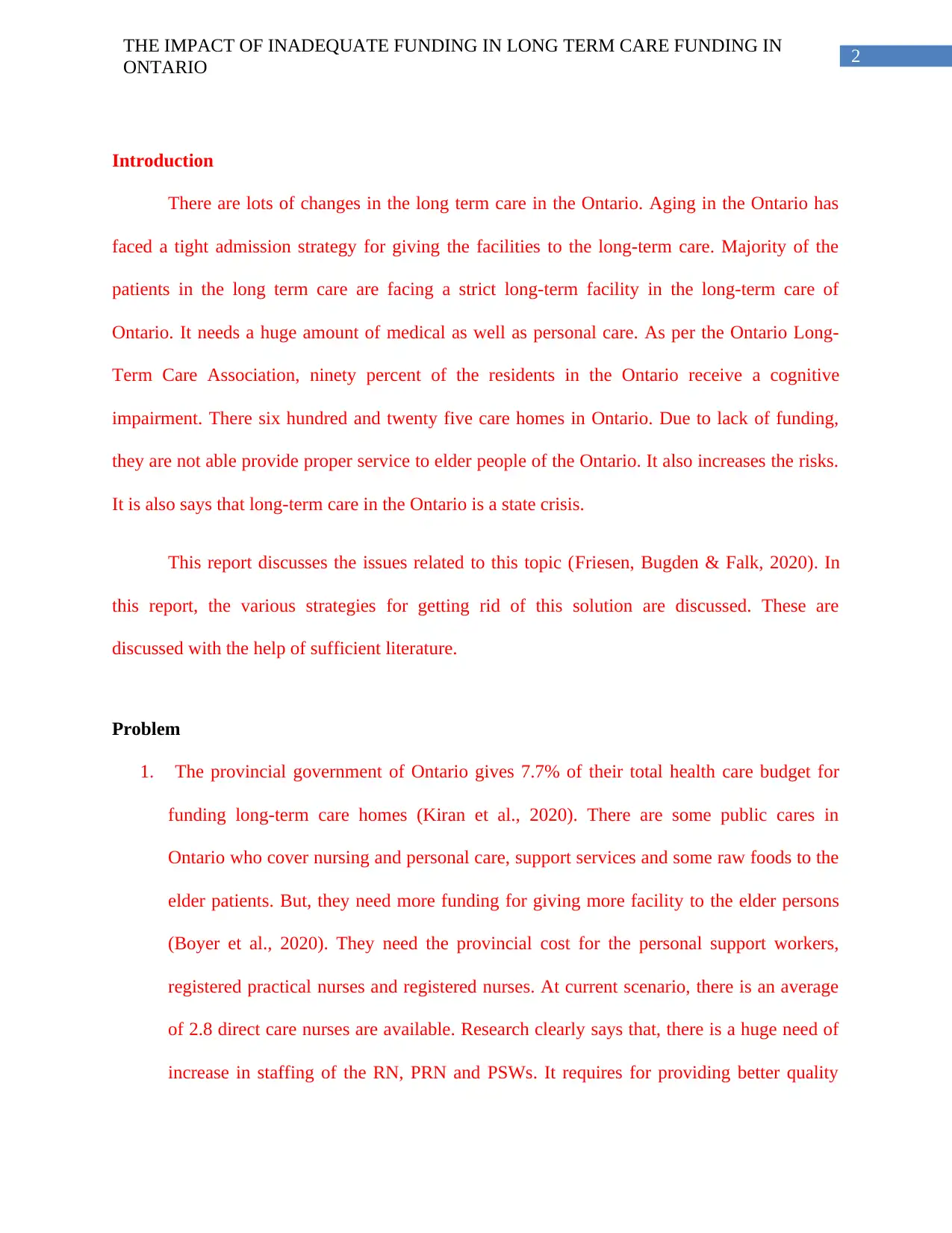
2
THE IMPACT OF INADEQUATE FUNDING IN LONG TERM CARE FUNDING IN
ONTARIO
Introduction
There are lots of changes in the long term care in the Ontario. Aging in the Ontario has
faced a tight admission strategy for giving the facilities to the long-term care. Majority of the
patients in the long term care are facing a strict long-term facility in the long-term care of
Ontario. It needs a huge amount of medical as well as personal care. As per the Ontario Long-
Term Care Association, ninety percent of the residents in the Ontario receive a cognitive
impairment. There six hundred and twenty five care homes in Ontario. Due to lack of funding,
they are not able provide proper service to elder people of the Ontario. It also increases the risks.
It is also says that long-term care in the Ontario is a state crisis.
This report discusses the issues related to this topic (Friesen, Bugden & Falk, 2020). In
this report, the various strategies for getting rid of this solution are discussed. These are
discussed with the help of sufficient literature.
Problem
1. The provincial government of Ontario gives 7.7% of their total health care budget for
funding long-term care homes (Kiran et al., 2020). There are some public cares in
Ontario who cover nursing and personal care, support services and some raw foods to the
elder patients. But, they need more funding for giving more facility to the elder persons
(Boyer et al., 2020). They need the provincial cost for the personal support workers,
registered practical nurses and registered nurses. At current scenario, there is an average
of 2.8 direct care nurses are available. Research clearly says that, there is a huge need of
increase in staffing of the RN, PRN and PSWs. It requires for providing better quality
THE IMPACT OF INADEQUATE FUNDING IN LONG TERM CARE FUNDING IN
ONTARIO
Introduction
There are lots of changes in the long term care in the Ontario. Aging in the Ontario has
faced a tight admission strategy for giving the facilities to the long-term care. Majority of the
patients in the long term care are facing a strict long-term facility in the long-term care of
Ontario. It needs a huge amount of medical as well as personal care. As per the Ontario Long-
Term Care Association, ninety percent of the residents in the Ontario receive a cognitive
impairment. There six hundred and twenty five care homes in Ontario. Due to lack of funding,
they are not able provide proper service to elder people of the Ontario. It also increases the risks.
It is also says that long-term care in the Ontario is a state crisis.
This report discusses the issues related to this topic (Friesen, Bugden & Falk, 2020). In
this report, the various strategies for getting rid of this solution are discussed. These are
discussed with the help of sufficient literature.
Problem
1. The provincial government of Ontario gives 7.7% of their total health care budget for
funding long-term care homes (Kiran et al., 2020). There are some public cares in
Ontario who cover nursing and personal care, support services and some raw foods to the
elder patients. But, they need more funding for giving more facility to the elder persons
(Boyer et al., 2020). They need the provincial cost for the personal support workers,
registered practical nurses and registered nurses. At current scenario, there is an average
of 2.8 direct care nurses are available. Research clearly says that, there is a huge need of
increase in staffing of the RN, PRN and PSWs. It requires for providing better quality
⊘ This is a preview!⊘
Do you want full access?
Subscribe today to unlock all pages.

Trusted by 1+ million students worldwide
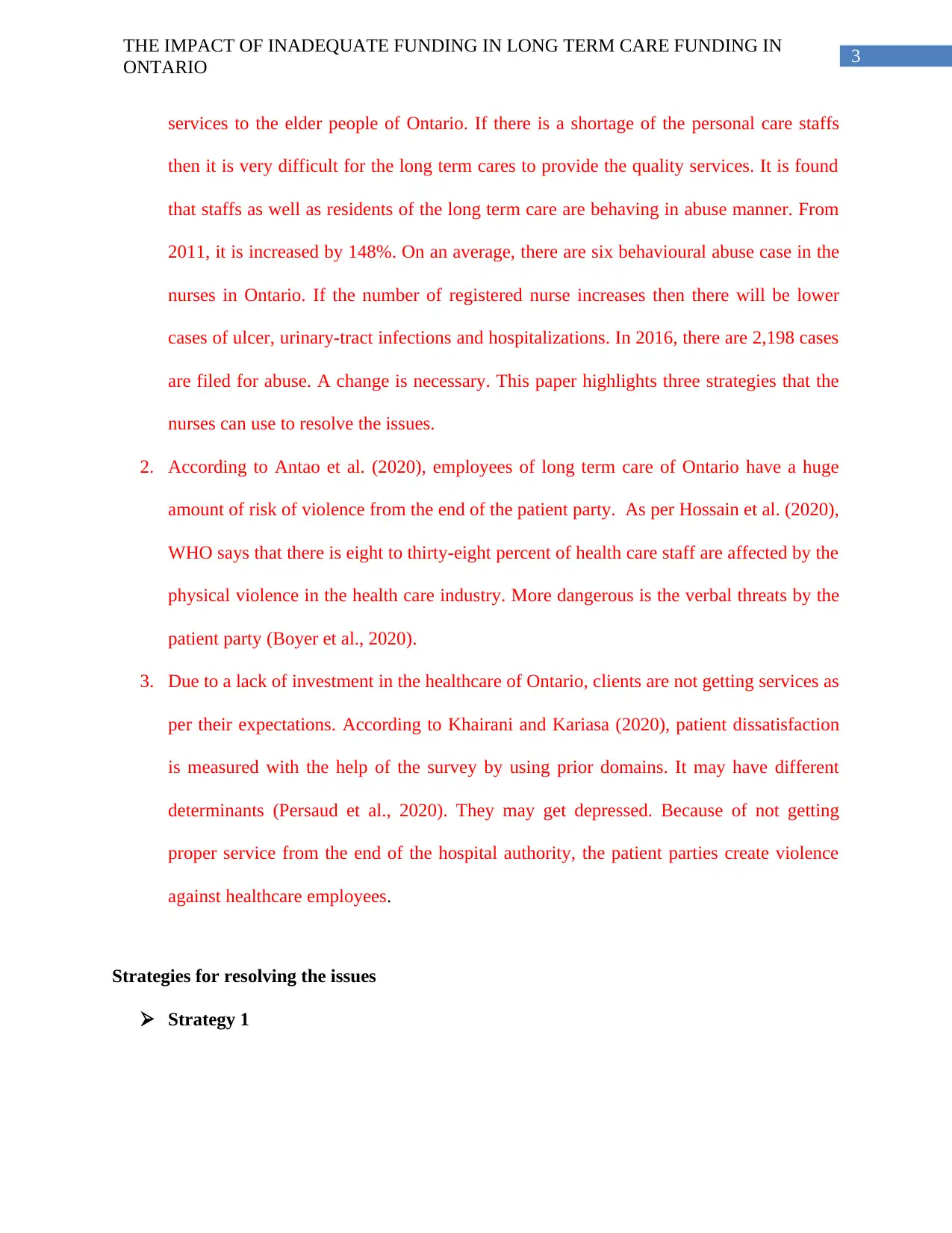
3
THE IMPACT OF INADEQUATE FUNDING IN LONG TERM CARE FUNDING IN
ONTARIO
services to the elder people of Ontario. If there is a shortage of the personal care staffs
then it is very difficult for the long term cares to provide the quality services. It is found
that staffs as well as residents of the long term care are behaving in abuse manner. From
2011, it is increased by 148%. On an average, there are six behavioural abuse case in the
nurses in Ontario. If the number of registered nurse increases then there will be lower
cases of ulcer, urinary-tract infections and hospitalizations. In 2016, there are 2,198 cases
are filed for abuse. A change is necessary. This paper highlights three strategies that the
nurses can use to resolve the issues.
2. According to Antao et al. (2020), employees of long term care of Ontario have a huge
amount of risk of violence from the end of the patient party. As per Hossain et al. (2020),
WHO says that there is eight to thirty-eight percent of health care staff are affected by the
physical violence in the health care industry. More dangerous is the verbal threats by the
patient party (Boyer et al., 2020).
3. Due to a lack of investment in the healthcare of Ontario, clients are not getting services as
per their expectations. According to Khairani and Kariasa (2020), patient dissatisfaction
is measured with the help of the survey by using prior domains. It may have different
determinants (Persaud et al., 2020). They may get depressed. Because of not getting
proper service from the end of the hospital authority, the patient parties create violence
against healthcare employees.
Strategies for resolving the issues
Strategy 1
THE IMPACT OF INADEQUATE FUNDING IN LONG TERM CARE FUNDING IN
ONTARIO
services to the elder people of Ontario. If there is a shortage of the personal care staffs
then it is very difficult for the long term cares to provide the quality services. It is found
that staffs as well as residents of the long term care are behaving in abuse manner. From
2011, it is increased by 148%. On an average, there are six behavioural abuse case in the
nurses in Ontario. If the number of registered nurse increases then there will be lower
cases of ulcer, urinary-tract infections and hospitalizations. In 2016, there are 2,198 cases
are filed for abuse. A change is necessary. This paper highlights three strategies that the
nurses can use to resolve the issues.
2. According to Antao et al. (2020), employees of long term care of Ontario have a huge
amount of risk of violence from the end of the patient party. As per Hossain et al. (2020),
WHO says that there is eight to thirty-eight percent of health care staff are affected by the
physical violence in the health care industry. More dangerous is the verbal threats by the
patient party (Boyer et al., 2020).
3. Due to a lack of investment in the healthcare of Ontario, clients are not getting services as
per their expectations. According to Khairani and Kariasa (2020), patient dissatisfaction
is measured with the help of the survey by using prior domains. It may have different
determinants (Persaud et al., 2020). They may get depressed. Because of not getting
proper service from the end of the hospital authority, the patient parties create violence
against healthcare employees.
Strategies for resolving the issues
Strategy 1
Paraphrase This Document
Need a fresh take? Get an instant paraphrase of this document with our AI Paraphraser
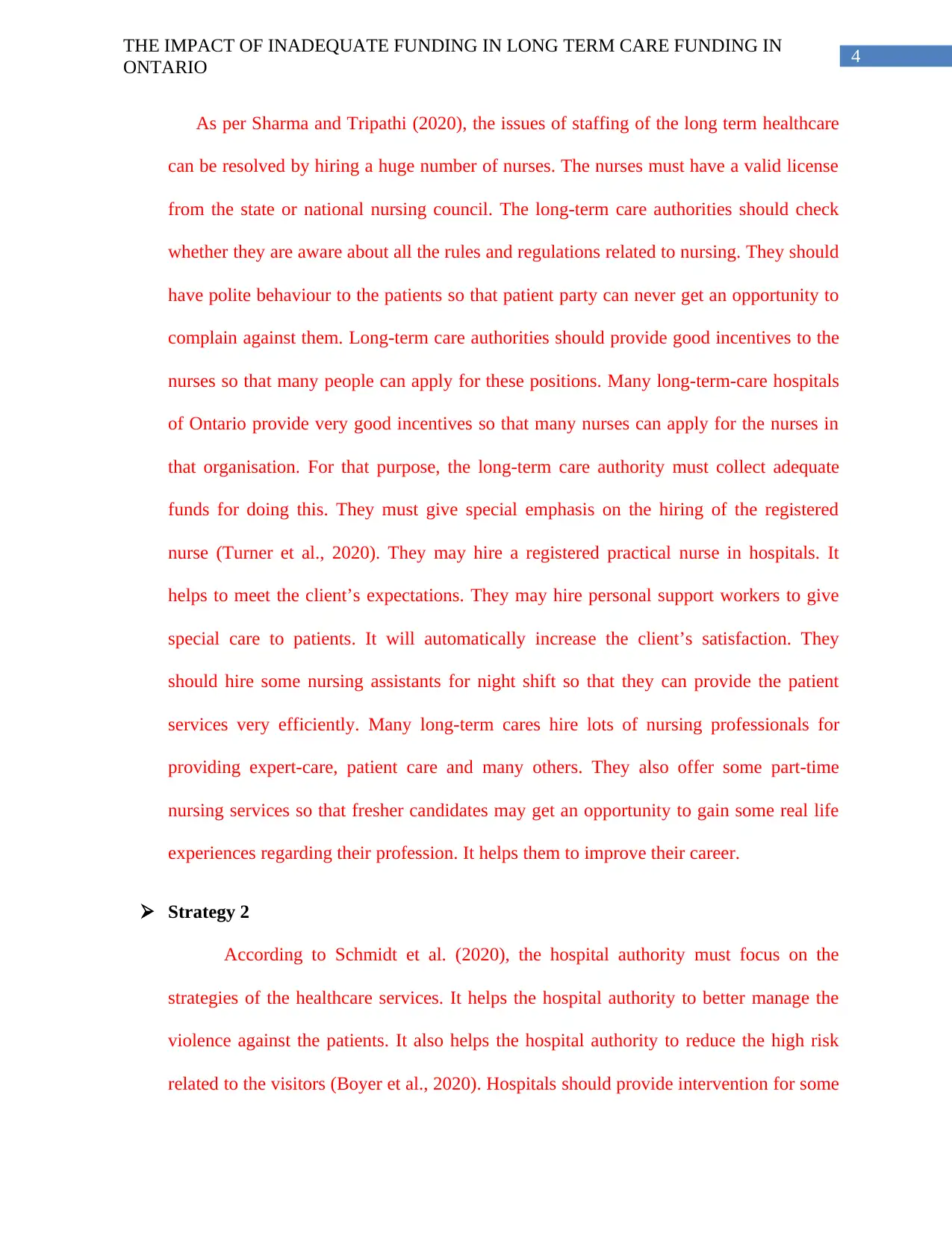
4
THE IMPACT OF INADEQUATE FUNDING IN LONG TERM CARE FUNDING IN
ONTARIO
As per Sharma and Tripathi (2020), the issues of staffing of the long term healthcare
can be resolved by hiring a huge number of nurses. The nurses must have a valid license
from the state or national nursing council. The long-term care authorities should check
whether they are aware about all the rules and regulations related to nursing. They should
have polite behaviour to the patients so that patient party can never get an opportunity to
complain against them. Long-term care authorities should provide good incentives to the
nurses so that many people can apply for these positions. Many long-term-care hospitals
of Ontario provide very good incentives so that many nurses can apply for the nurses in
that organisation. For that purpose, the long-term care authority must collect adequate
funds for doing this. They must give special emphasis on the hiring of the registered
nurse (Turner et al., 2020). They may hire a registered practical nurse in hospitals. It
helps to meet the client’s expectations. They may hire personal support workers to give
special care to patients. It will automatically increase the client’s satisfaction. They
should hire some nursing assistants for night shift so that they can provide the patient
services very efficiently. Many long-term cares hire lots of nursing professionals for
providing expert-care, patient care and many others. They also offer some part-time
nursing services so that fresher candidates may get an opportunity to gain some real life
experiences regarding their profession. It helps them to improve their career.
Strategy 2
According to Schmidt et al. (2020), the hospital authority must focus on the
strategies of the healthcare services. It helps the hospital authority to better manage the
violence against the patients. It also helps the hospital authority to reduce the high risk
related to the visitors (Boyer et al., 2020). Hospitals should provide intervention for some
THE IMPACT OF INADEQUATE FUNDING IN LONG TERM CARE FUNDING IN
ONTARIO
As per Sharma and Tripathi (2020), the issues of staffing of the long term healthcare
can be resolved by hiring a huge number of nurses. The nurses must have a valid license
from the state or national nursing council. The long-term care authorities should check
whether they are aware about all the rules and regulations related to nursing. They should
have polite behaviour to the patients so that patient party can never get an opportunity to
complain against them. Long-term care authorities should provide good incentives to the
nurses so that many people can apply for these positions. Many long-term-care hospitals
of Ontario provide very good incentives so that many nurses can apply for the nurses in
that organisation. For that purpose, the long-term care authority must collect adequate
funds for doing this. They must give special emphasis on the hiring of the registered
nurse (Turner et al., 2020). They may hire a registered practical nurse in hospitals. It
helps to meet the client’s expectations. They may hire personal support workers to give
special care to patients. It will automatically increase the client’s satisfaction. They
should hire some nursing assistants for night shift so that they can provide the patient
services very efficiently. Many long-term cares hire lots of nursing professionals for
providing expert-care, patient care and many others. They also offer some part-time
nursing services so that fresher candidates may get an opportunity to gain some real life
experiences regarding their profession. It helps them to improve their career.
Strategy 2
According to Schmidt et al. (2020), the hospital authority must focus on the
strategies of the healthcare services. It helps the hospital authority to better manage the
violence against the patients. It also helps the hospital authority to reduce the high risk
related to the visitors (Boyer et al., 2020). Hospitals should provide intervention for some

5
THE IMPACT OF INADEQUATE FUNDING IN LONG TERM CARE FUNDING IN
ONTARIO
emergency purpose for ensuring various physical securities of the health care facilities.
As per Lee et al. (2020), WHO, ILO, ICN and PSI collaboratly develop some framework
guideline which helps the hospital to prevent the violence among the employees of
healthcare sector. It also helps the hospitals to prevent the violence in non-emergency
settings. WHO also suggests the hospitals to perform the systematic collection of data
regarding the violence against the employees. It helps the hospital authority to take some
preventive measure against the violation among the employees.
Strategy 3
Nursing in Ontario is treated as the latest profession in the long term care industry
of Ontario. They have some ethical obligation to influence various public policies in the
long-term care with the help of some political action. There should be a modification in
legislation in funding for long-term care. For that reason, political action will play a vital
role. Nurses are supported by several legislative as well as federal organisations in
Ontario. A strategy of political advocacy is required for this change. It can be used by the
Registered Nurses Association of Ontario. Nurses can verbally raise this issue regarding
shortage of employees in the LTC centres of Ontario. They can suggest that to the
Minister of Health of the Ontario. Every political leader must have a sound knowledge
regarding the public health policy of Ontario. They can involve a large amount of people
for raising voice regarding the employee shortage in the long-term care. A large
population of the people of Ontario is facing problems due to the funding cut back of
long term care.
THE IMPACT OF INADEQUATE FUNDING IN LONG TERM CARE FUNDING IN
ONTARIO
emergency purpose for ensuring various physical securities of the health care facilities.
As per Lee et al. (2020), WHO, ILO, ICN and PSI collaboratly develop some framework
guideline which helps the hospital to prevent the violence among the employees of
healthcare sector. It also helps the hospitals to prevent the violence in non-emergency
settings. WHO also suggests the hospitals to perform the systematic collection of data
regarding the violence against the employees. It helps the hospital authority to take some
preventive measure against the violation among the employees.
Strategy 3
Nursing in Ontario is treated as the latest profession in the long term care industry
of Ontario. They have some ethical obligation to influence various public policies in the
long-term care with the help of some political action. There should be a modification in
legislation in funding for long-term care. For that reason, political action will play a vital
role. Nurses are supported by several legislative as well as federal organisations in
Ontario. A strategy of political advocacy is required for this change. It can be used by the
Registered Nurses Association of Ontario. Nurses can verbally raise this issue regarding
shortage of employees in the LTC centres of Ontario. They can suggest that to the
Minister of Health of the Ontario. Every political leader must have a sound knowledge
regarding the public health policy of Ontario. They can involve a large amount of people
for raising voice regarding the employee shortage in the long-term care. A large
population of the people of Ontario is facing problems due to the funding cut back of
long term care.
⊘ This is a preview!⊘
Do you want full access?
Subscribe today to unlock all pages.

Trusted by 1+ million students worldwide

6
THE IMPACT OF INADEQUATE FUNDING IN LONG TERM CARE FUNDING IN
ONTARIO
Conclusion
In Ontario, long term care is facing a huge amount of issues in providing facility to the
clients due to the lack of funds. Governments, as well as various NGOs, are not providing a
sufficient amount of funds to the long term care. If they provide necessary funds then it will help
to improve the long term care in Ontario. Hospitals should purchase huge amount of medical
equipment so that they can provide outstanding medical services. For that reason, they are not
able to meet the requirements of the clients. That is why several strategies are discussed for
meeting the client’s requirements. In the end, it can be said that, with the help of the above
mentioned strategies, it is possible to meet the client’s demand.
THE IMPACT OF INADEQUATE FUNDING IN LONG TERM CARE FUNDING IN
ONTARIO
Conclusion
In Ontario, long term care is facing a huge amount of issues in providing facility to the
clients due to the lack of funds. Governments, as well as various NGOs, are not providing a
sufficient amount of funds to the long term care. If they provide necessary funds then it will help
to improve the long term care in Ontario. Hospitals should purchase huge amount of medical
equipment so that they can provide outstanding medical services. For that reason, they are not
able to meet the requirements of the clients. That is why several strategies are discussed for
meeting the client’s requirements. In the end, it can be said that, with the help of the above
mentioned strategies, it is possible to meet the client’s demand.
Paraphrase This Document
Need a fresh take? Get an instant paraphrase of this document with our AI Paraphraser
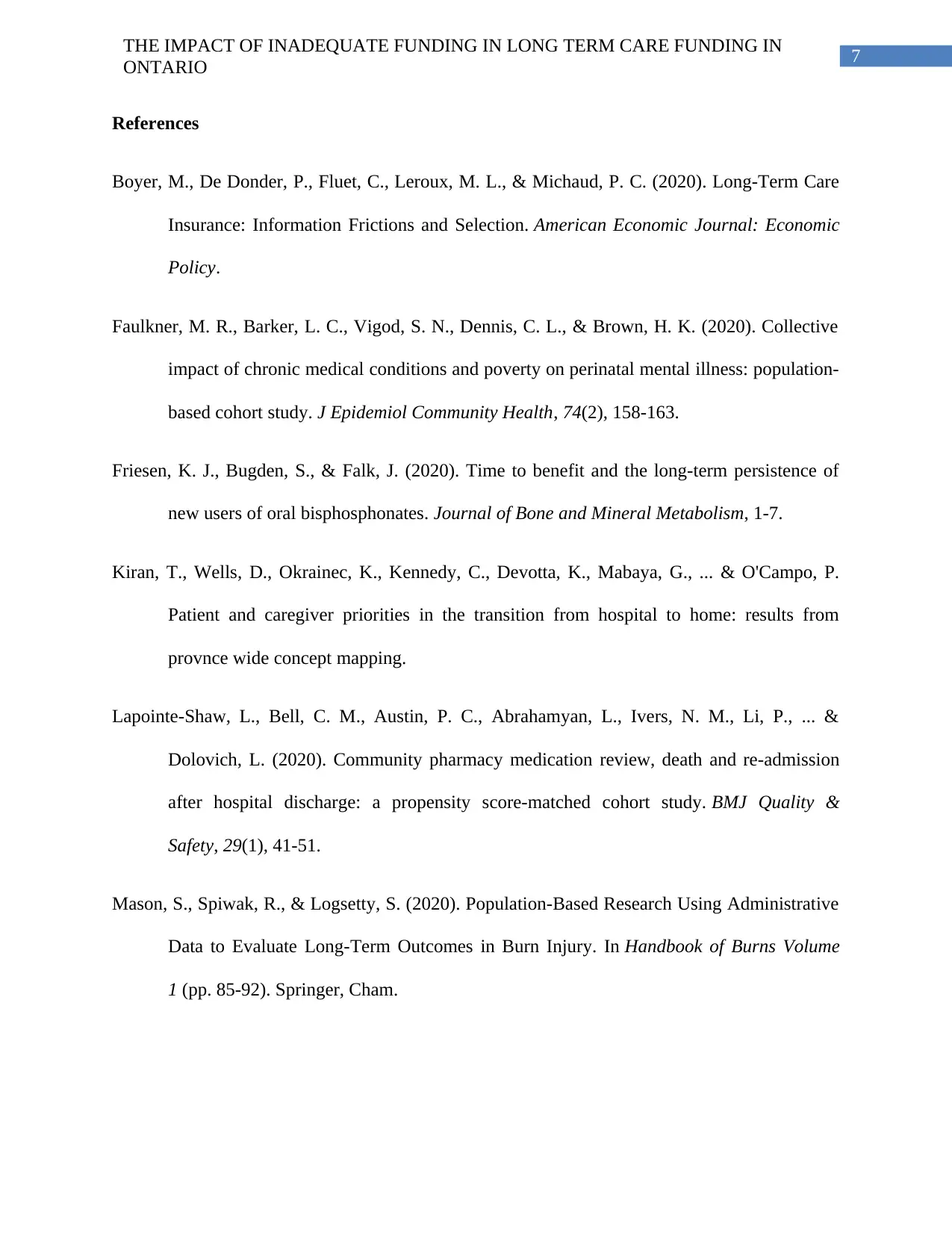
7
THE IMPACT OF INADEQUATE FUNDING IN LONG TERM CARE FUNDING IN
ONTARIO
References
Boyer, M., De Donder, P., Fluet, C., Leroux, M. L., & Michaud, P. C. (2020). Long-Term Care
Insurance: Information Frictions and Selection. American Economic Journal: Economic
Policy.
Faulkner, M. R., Barker, L. C., Vigod, S. N., Dennis, C. L., & Brown, H. K. (2020). Collective
impact of chronic medical conditions and poverty on perinatal mental illness: population-
based cohort study. J Epidemiol Community Health, 74(2), 158-163.
Friesen, K. J., Bugden, S., & Falk, J. (2020). Time to benefit and the long-term persistence of
new users of oral bisphosphonates. Journal of Bone and Mineral Metabolism, 1-7.
Kiran, T., Wells, D., Okrainec, K., Kennedy, C., Devotta, K., Mabaya, G., ... & O'Campo, P.
Patient and caregiver priorities in the transition from hospital to home: results from
provnce wide concept mapping.
Lapointe-Shaw, L., Bell, C. M., Austin, P. C., Abrahamyan, L., Ivers, N. M., Li, P., ... &
Dolovich, L. (2020). Community pharmacy medication review, death and re-admission
after hospital discharge: a propensity score-matched cohort study. BMJ Quality &
Safety, 29(1), 41-51.
Mason, S., Spiwak, R., & Logsetty, S. (2020). Population-Based Research Using Administrative
Data to Evaluate Long-Term Outcomes in Burn Injury. In Handbook of Burns Volume
1 (pp. 85-92). Springer, Cham.
THE IMPACT OF INADEQUATE FUNDING IN LONG TERM CARE FUNDING IN
ONTARIO
References
Boyer, M., De Donder, P., Fluet, C., Leroux, M. L., & Michaud, P. C. (2020). Long-Term Care
Insurance: Information Frictions and Selection. American Economic Journal: Economic
Policy.
Faulkner, M. R., Barker, L. C., Vigod, S. N., Dennis, C. L., & Brown, H. K. (2020). Collective
impact of chronic medical conditions and poverty on perinatal mental illness: population-
based cohort study. J Epidemiol Community Health, 74(2), 158-163.
Friesen, K. J., Bugden, S., & Falk, J. (2020). Time to benefit and the long-term persistence of
new users of oral bisphosphonates. Journal of Bone and Mineral Metabolism, 1-7.
Kiran, T., Wells, D., Okrainec, K., Kennedy, C., Devotta, K., Mabaya, G., ... & O'Campo, P.
Patient and caregiver priorities in the transition from hospital to home: results from
provnce wide concept mapping.
Lapointe-Shaw, L., Bell, C. M., Austin, P. C., Abrahamyan, L., Ivers, N. M., Li, P., ... &
Dolovich, L. (2020). Community pharmacy medication review, death and re-admission
after hospital discharge: a propensity score-matched cohort study. BMJ Quality &
Safety, 29(1), 41-51.
Mason, S., Spiwak, R., & Logsetty, S. (2020). Population-Based Research Using Administrative
Data to Evaluate Long-Term Outcomes in Burn Injury. In Handbook of Burns Volume
1 (pp. 85-92). Springer, Cham.
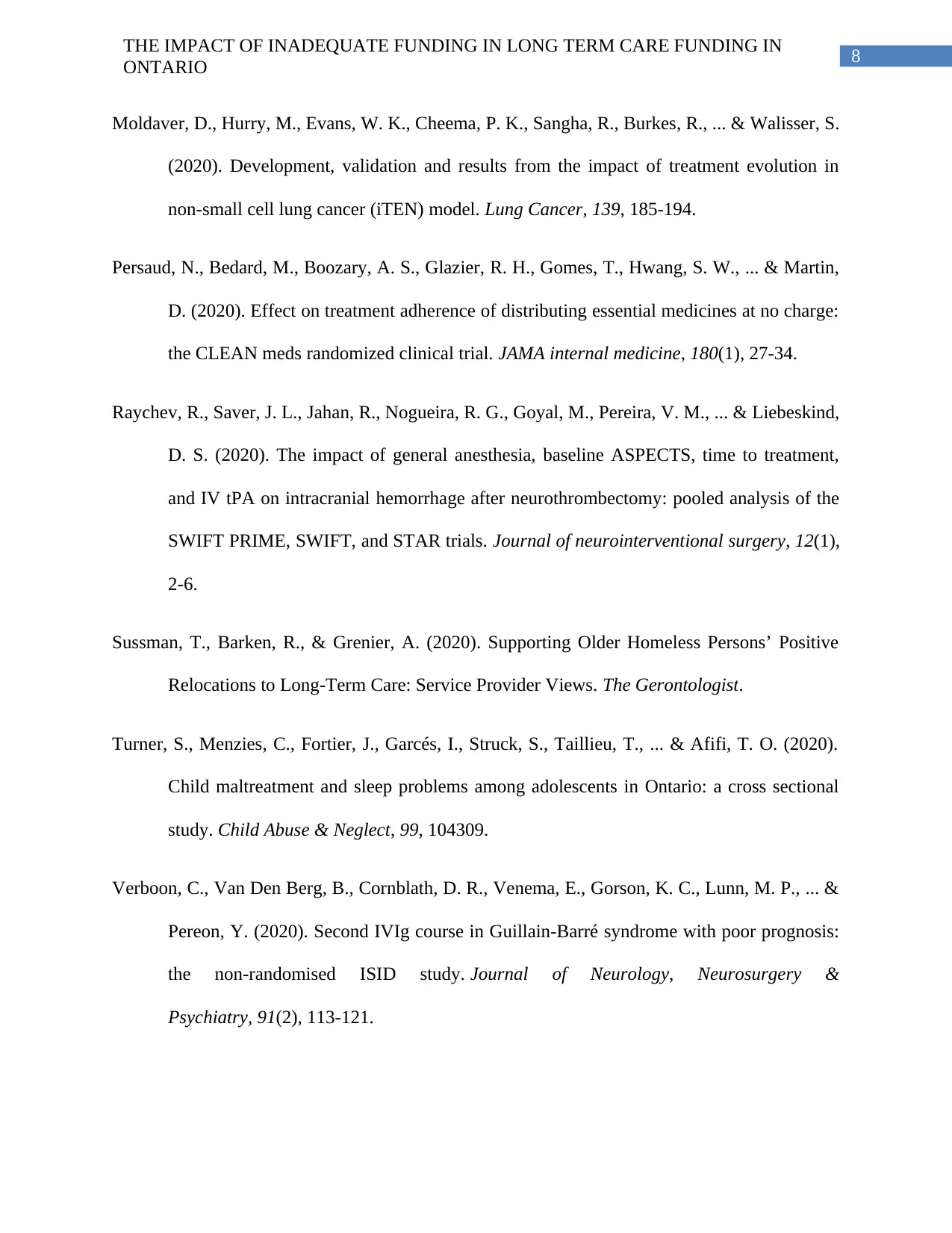
8
THE IMPACT OF INADEQUATE FUNDING IN LONG TERM CARE FUNDING IN
ONTARIO
Moldaver, D., Hurry, M., Evans, W. K., Cheema, P. K., Sangha, R., Burkes, R., ... & Walisser, S.
(2020). Development, validation and results from the impact of treatment evolution in
non-small cell lung cancer (iTEN) model. Lung Cancer, 139, 185-194.
Persaud, N., Bedard, M., Boozary, A. S., Glazier, R. H., Gomes, T., Hwang, S. W., ... & Martin,
D. (2020). Effect on treatment adherence of distributing essential medicines at no charge:
the CLEAN meds randomized clinical trial. JAMA internal medicine, 180(1), 27-34.
Raychev, R., Saver, J. L., Jahan, R., Nogueira, R. G., Goyal, M., Pereira, V. M., ... & Liebeskind,
D. S. (2020). The impact of general anesthesia, baseline ASPECTS, time to treatment,
and IV tPA on intracranial hemorrhage after neurothrombectomy: pooled analysis of the
SWIFT PRIME, SWIFT, and STAR trials. Journal of neurointerventional surgery, 12(1),
2-6.
Sussman, T., Barken, R., & Grenier, A. (2020). Supporting Older Homeless Persons’ Positive
Relocations to Long-Term Care: Service Provider Views. The Gerontologist.
Turner, S., Menzies, C., Fortier, J., Garcés, I., Struck, S., Taillieu, T., ... & Afifi, T. O. (2020).
Child maltreatment and sleep problems among adolescents in Ontario: a cross sectional
study. Child Abuse & Neglect, 99, 104309.
Verboon, C., Van Den Berg, B., Cornblath, D. R., Venema, E., Gorson, K. C., Lunn, M. P., ... &
Pereon, Y. (2020). Second IVIg course in Guillain-Barré syndrome with poor prognosis:
the non-randomised ISID study. Journal of Neurology, Neurosurgery &
Psychiatry, 91(2), 113-121.
THE IMPACT OF INADEQUATE FUNDING IN LONG TERM CARE FUNDING IN
ONTARIO
Moldaver, D., Hurry, M., Evans, W. K., Cheema, P. K., Sangha, R., Burkes, R., ... & Walisser, S.
(2020). Development, validation and results from the impact of treatment evolution in
non-small cell lung cancer (iTEN) model. Lung Cancer, 139, 185-194.
Persaud, N., Bedard, M., Boozary, A. S., Glazier, R. H., Gomes, T., Hwang, S. W., ... & Martin,
D. (2020). Effect on treatment adherence of distributing essential medicines at no charge:
the CLEAN meds randomized clinical trial. JAMA internal medicine, 180(1), 27-34.
Raychev, R., Saver, J. L., Jahan, R., Nogueira, R. G., Goyal, M., Pereira, V. M., ... & Liebeskind,
D. S. (2020). The impact of general anesthesia, baseline ASPECTS, time to treatment,
and IV tPA on intracranial hemorrhage after neurothrombectomy: pooled analysis of the
SWIFT PRIME, SWIFT, and STAR trials. Journal of neurointerventional surgery, 12(1),
2-6.
Sussman, T., Barken, R., & Grenier, A. (2020). Supporting Older Homeless Persons’ Positive
Relocations to Long-Term Care: Service Provider Views. The Gerontologist.
Turner, S., Menzies, C., Fortier, J., Garcés, I., Struck, S., Taillieu, T., ... & Afifi, T. O. (2020).
Child maltreatment and sleep problems among adolescents in Ontario: a cross sectional
study. Child Abuse & Neglect, 99, 104309.
Verboon, C., Van Den Berg, B., Cornblath, D. R., Venema, E., Gorson, K. C., Lunn, M. P., ... &
Pereon, Y. (2020). Second IVIg course in Guillain-Barré syndrome with poor prognosis:
the non-randomised ISID study. Journal of Neurology, Neurosurgery &
Psychiatry, 91(2), 113-121.
⊘ This is a preview!⊘
Do you want full access?
Subscribe today to unlock all pages.

Trusted by 1+ million students worldwide

9
THE IMPACT OF INADEQUATE FUNDING IN LONG TERM CARE FUNDING IN
ONTARIO
THE IMPACT OF INADEQUATE FUNDING IN LONG TERM CARE FUNDING IN
ONTARIO
1 out of 10
Related Documents
Your All-in-One AI-Powered Toolkit for Academic Success.
+13062052269
info@desklib.com
Available 24*7 on WhatsApp / Email
![[object Object]](/_next/static/media/star-bottom.7253800d.svg)
Unlock your academic potential
Copyright © 2020–2025 A2Z Services. All Rights Reserved. Developed and managed by ZUCOL.




